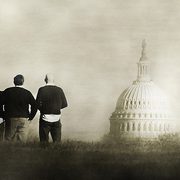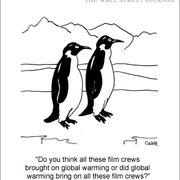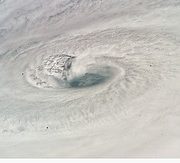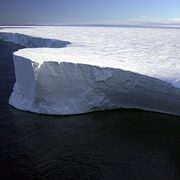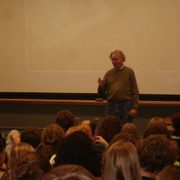-
Via the AP, important news for the wonks in our audience:
“Lawmakers took the first step Thursday on a bipartisan global warming bill that would impose mandatory cuts in greenhouse gases from power plants, industrial facilities and transportation.
Sen. Joe Lieberman, I-Conn., pushed the legislation out of his global warming subcommittee by a 4-3 vote, agreeing to a number of changes aimed primarily at garnering the needed majority to advance it.”
Continue by clicking the “read more” link below
-
Correlation or Causation?
To see the image click the “read more” link below
-
Speaking at Carleton on Wednesday evening, Kerry Emanuel presented a fascinating picture of hurricanes in their relation to global warming. Emanuel, a professor of Earth, Atmospheric, and Planetary Sciences at the Massachusetts Institute of Technology, is known as a foremost expert in the small but increasingly important field concerning the impact of climate upon the number and intensity of hurricanes. In his remarks Wednesday night, Emanuel described some of the basic science behind hurricanes before delving into the research that has been done regarding trends in hurricane power (which he argued is a more important metric that hurricane number). Over the past century, ocean temperature has shown a strong correlation with hurricane power. Since increased ocean temperatures are one of the more direct impacts of global warming, this relationship could have real impacts upon coastal communities.
Continue by clicking the “read more” link below
-
Though the most recent data concerning Arctic sea ice melting has received attention in the media, it is hard for most to grasp what “record melting” means. “Record melting” is difficult to show in one simple figure and to understand in a historical context. In the New York Times, two weeks ago, the Science section put up a great interactive graphic which really demonstrates how quickly the ice is melting. I strongly recommend that you check this feature out.
Continue by clicking the “read more” link below
-
Hurricane Expert to Speak at Carleton
On Wednesday, October 17, Kerry Emanuel will deliver a lecture entitled “Global Warming and Hurricanes.” Dr. Emanuel, a meteorologist at MIT, has written a number of books on the subjects of hurricanes and climate change, the most recent of which is What We Know about Climate Change (Boston Review Books). In his research, Dr. Emanuel has found connections between climate change and increased hurricane intensity. In the wake of Hurricane Katrina, Dr. Emanuel was named to Time Magazine’s list of the 100 most influential people. The talk continues a yearlong public lecture series on the topic of climate change hosted by Carleton’s Environmental and Technology Studies program.
Dr. Emanuel will lead an informal discussion at 4:00pm in Olin 103. His lecture will begin at 7:30pm in Boliou Hall, room 104. Refreshments will be served afterwards. Both events are free and open to the public. For more information, contact Adam Smith.
Read a recent review of What We Know about Climate Change, written by Bill McKibben.
-
Carleton students and faculty members packed the Boliou lecture hall last Wednesday to hear geochemist Wally Broecker deliver a lecture entitled “How to Terminate a Glacial Period.” Dr. Broecker, the Newberry Professor of Earth and Environmental Sciences at Columbia University, described new research that gives insight into the Younger Dryas period, a time of cold climate conditions eleven to twelve thousand years ago. In the ongoing research of global warming, this era serves as a particularly interesting example of a time of rapid climate change, when the thermohaline conveyer of ocean currents suddenly shut down, possibly as a result of the flooding of ancient Lake Agassiz (present day Great Lakes) into the Atlantic Ocean. Dr. Broecker has written that the Younger Dryas “holds the key to understanding abrupt climate change” and thus, merits extensive research given our current situation with global warming.
Continue by clicking the “read more” link below
Categories
- Building and Planning
- Carleton's Wind Turbines
- Climate Change
- Conferences
- Cowling Arboretum
- Ecosystem Management
- Emissions and Offsets
- Energy Sources & Uses
- Environmental Justice
- Events
- Food
- Higher Education
- International News
- National News
- News
- STA Program
- Student Life
- Student Projects
- Sustainability
- Sustainable Planning & Development
- Transportation
- Waste
